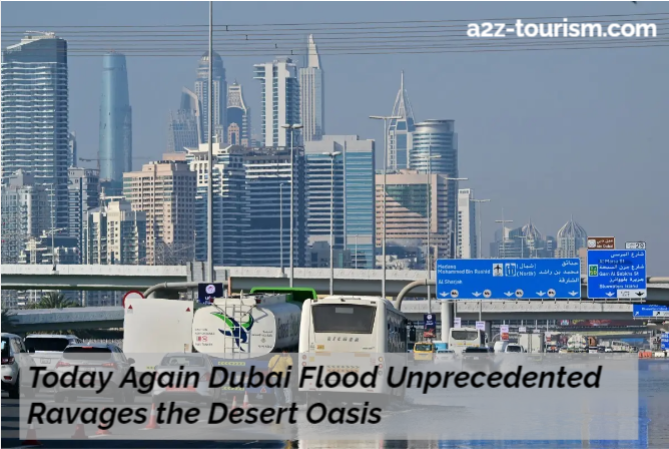Dubai known for its towering high rises, luxurious way of life, and flourishing economy, has as of late faced a phenomenal characteristic disasterâ-devastating Dubai Flood. In a stark flight from its desert climate, heavy rains swept over the city, wreaking havoc and taking off behind a path of destruction. This article will delve into the full details of the Dubai Flood, examining its causes, the effect on infrastructure and residents, and the reaction efforts.
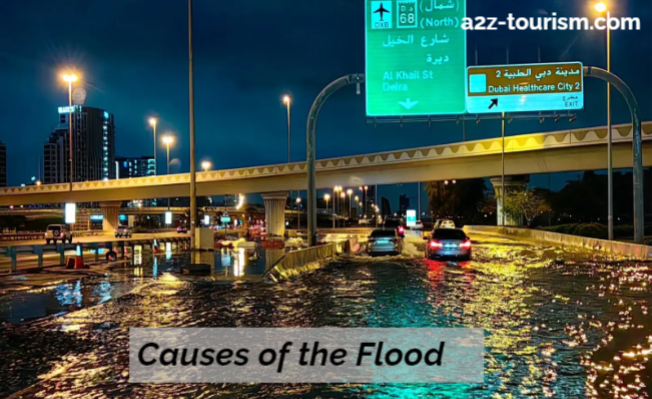
Causes of the Flood
The Dubai flood can be credited to a combination of variables, including a serious weather framework and insufficient framework readiness. The locale experienced a curiously overwhelming downpour, exceeding the city’s seepage systems‘ capacity to cope with the intemperate sum of water. The fast urbanization and broad development ventures in Dubai may have moreover contributed to the lack of waste systems, worsening the situation.
The Deluge and its Effects
In a surprising turn of occasions, the United Arab Emirates (UAE), famous for its parched climate, saw an uncommon deluge of precipitation that outperformed the country’s normal annual precipitation in less than 24 hours. This storm brought about the formation of streak floods on April 16, causing chaos as cars were submerged and streets turned into waterways. The severity of the flooding caught residents off guard, as the UAE isn’t usual to such heavy rainfall, leading to critical disruptions and challenges for the affected areas.
The country’s infrastructure, including schools, businesses, and transportation systems, suffered severe harm. The way of life was disturbed as residents lost access to power, water, and basic services. The storms caused chaos and cleared out numerous people stranded in their homes, airports, or wherever they happened to be when the floods struck.
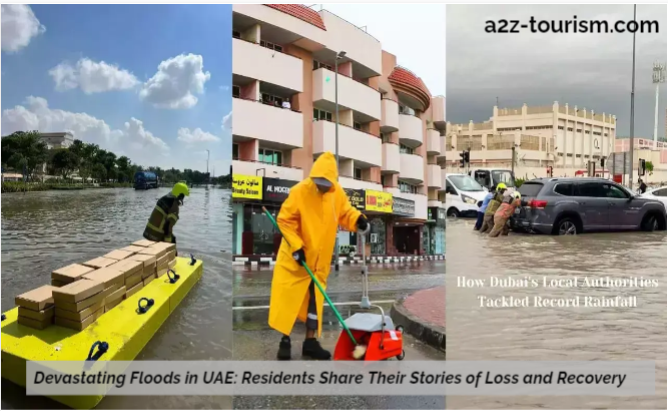
Devastating Floods in UAE: Residents Share Their Stories of Loss and Recovery
Unprecedented rainfall within the United Arab Emirates (UAE) has brought about broad harm and hardship for inhabitants throughout the country. Individual accounts from people who have seen the floods firsthand paint a distinctive picture of the injury they persevered and the impediments they experienced on the street to recovery. This article sheds light on the experiences of two residents and explores the ongoing endeavors to rebuild and restore normalcy in the UAE.
Adriana Pagliero’s Nightmare
Adriana Pagliero, a resident of Mirdif, Dubai, confronted a living bad dream when floodwaters spouted into her home amid the overwhelming rainfall. Videos shared by Pagliero showed water pouring in from entryways and ceilings, causing basic damage and taking off her furniture and important craftsmanship collections drifting within the floodwater.
She estimated the harm to her belongings at around Dh1 million. Pagliero, her girl, and their pets have been constrained to live in a hotel while her spouse remains at the estate, assessing the ruins of their assets. The misfortune of their cherished possessions, including books, pictures, and family history, has been destroying the Italian-Canadian family.
Grace Karim and Somia Anway’s Bookstore Struggles
Grace Karim and Somia Anway, co-owners of Bookends, a bookstore in Dubai, also experienced significant losses due to the floods. The bookstore, found in Dubai Silicon Oasis, was attacked by floodwaters that submerged around 10,000 books, rendering them irreparably harmed. The store’s wooden bookshelves and fittings were moreover extremely influenced.
The proprietors have been working resolutely to pump out the water and commence the daunting cleanup handle. In any case, the challenge of managing with tireless dampness and seepage remains. They are focusing on rebuilding their site to regain lost revenue and offset the repair costs and progressing expenses. Despite the difficult circumstances, they have been cheered by the back and liberality of the community.
Impact on Infrastructure
The flood severely impacted Dubai’s infrastructure, causing significant harm to roads, bridges, buildings, and public utilities. Low-lying ranges and neighborhoods close to water bodies were particularly defenseless, with floodwaters inundating streets and residential areas. The city’s transportation arrangement faced disturbances, as numerous roads were obstructed due to flooding, driving activity congestion, and delays. Additionally, open administrations such as power, water supply, and telecommunications were disrupted in a few regions, compounding the challenges confronted by the residents.
Impact on Residents
The residents of Dubai were caught off watch by the size of the surge. Many homes and businesses suffered broad water damage, resulting in loss of property and personal assets. Thousands of people were uprooted from their homes, seeking temporary shields in departure centers and lodgings. The surge too posed dangers to open well-being, with concerns concerning water contamination, the spread of waterborne maladies, and the requirement for crisis therapeutic help.
Response Efforts
The Dubai government swiftly mobilized reaction groups and propelled a facilitated exertion to oversee the aftermath of the flood. The Civil Defense and Emergency Services were instrumental in carrying out protection operations, evacuating inhabitants from affected areas, and guaranteeing their security. Temporary covers were set up to provide displaced individuals with accommodation, food, and medical back. The specialists collaborated with neighborhood organizations, businesses, and volunteers to supply help supplies and basic assets to those in need.
The government too focused on reestablishing crucial foundations and services. Repair groups were deployed to evaluate and repair harmed streets, bridges, and open utilities. Efforts were made to restore electricity, water supply, and media transmission administrations within the affected ranges. Also, measures were taken to improve the drainage systems and enhance the city’s versatility to future flooding incidents.
Lessons Learned and Future Preparations
The Dubai flood serves as a wake-up call for the city’s specialists and urban planners to reevaluate their foundation readiness in the face of extraordinary weather events. It highlights the requirement for comprehensive surge administration procedures, including vigorous drainage systems, flood-resistant building plans, and improved urban planning hones. The government may consider contributing to early warning systems, surge forecasting technologies, and open mindfulness campaigns to guarantee that inhabitants are enough arranged and informed during such crises.
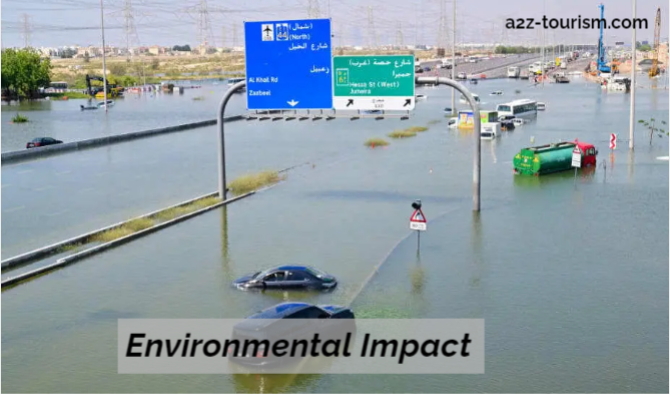
Environmental Impact
The ecological effect of the Dubai surge was critical. The sudden influx of water overpowered the delicate leave ecosystem, causing damage to plants and animal habitats. The surge too driven to soil disintegration and defilement, posturing long-term challenges for the region’s rural division. Endeavors to reestablish the influenced zones and relieve the natural results are anticipated to be broad and time-consuming.
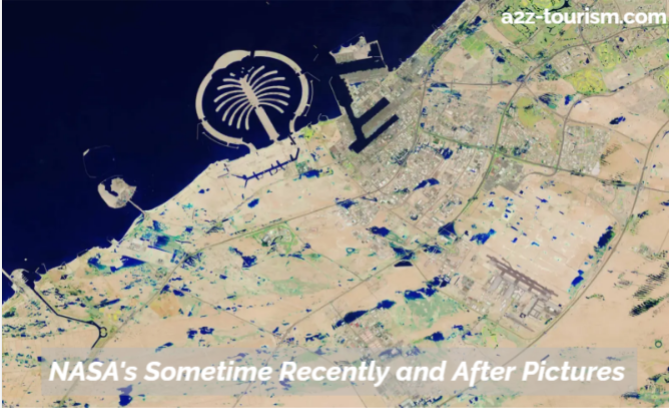
NASA’s Sometime Recently and After Pictures
Using Landsat information from the U.S. Geological Study, NASA captured partisan pictures before and after the storms. The images reveal the extent of the flooding, with large patches of water covering the forsake and urban areas. The second picture, taken on April 19, shows the flooded areas in the wrong color, utilizing blue for the nearness of the water. Landmarks such as Sheik Zayed Street, a major lane, were submerged, and private areas like Khalifa City and Zayed City were also significantly affected.
Recovery Efforts and Ongoing Challenges
The UAE government has been actively included in the recovery preparation, with agents going to affected inhabitants and surveying the harm. They are working to restore homes and infrastructure to enable residents to return to ordinary life. Be that as it may, the scale of the calamity and the degree of the harm display significant challenges. Numerous inhabitants are still hooking with the misfortune of their possessions and the enthusiastic toll caused by the surges. The cleanup efforts continue, and the government is doing its best to provide support and assistance to those affected.
Government Response and Recovery Efforts
Dubai’s government swiftly mobilized its assets to reply to the emergency. The Gracious Defense, police, and other crisis services were conveyed to protect stranded people and give help. Brief covers were set up to offer settlement, nourishment, and medical help to those influenced. The government too collaborated with international organizations and neighboring countries to support their help endeavors.
In the repercussions of the surge, the center moved towards recuperation and rebuilding. The harmed infrastructure, including roads, bridges, and public utilities, got quick attention to reestablish normalcy. The government started comprehensive evaluations to distinguish vulnerabilities in the drainage systems and prioritize necessary upgrades. Long-term plans were developed to upgrade the city’s resilience to future extreme weather events.
Conclusion
The recent flood in Dubai was an unprecedented incident that took the city and its residents by astonish. The heavy rainfall, coupled with insufficient waste systems, resulted in far-reaching destruction, impacting both the city’s physical foundation and the lives of its individuals. Be that as it may, the city’s incited reaction and collaboration with different partners illustrated strength and determination in the face of misfortune. As Dubai modifies and fortifies its infrastructure, profitable lessons will be learned to better get ready for and mitigate the effects of future natural disasters.
FAQs
What were the main causes of the floods in Dubai?
The floods in Dubai were primarily caused by an intense climate framework that brought curiously overwhelming precipitation, surpassing the city’s waste systems’ capacity. Rapid urbanization and lacking framework may have too contributed to the flooding.
How did the floods impact Dubai’s infrastructure and residents?
The floods extremely affected Dubai’s infrastructure, causing significant harm to roads, bridges, buildings, and public utilities. Many homes and businesses endured broad water harm, resulting in the misfortune of property and personal assets. Thousands of individuals were uprooted from their homes, looking for brief shields in departure centers and hotels.
What were the response efforts following the floods in Dubai?
The Dubai government swiftly mobilized reaction groups and propelled a facilitated exertion to oversee the consequences of the flood. The Respectful Defense and Crisis Administrations carried out protection operations, emptied inhabitants from affected zones, and ensured their security. Transitory covers were set up to provide displaced people with accommodation, nourishment, and restorative back. Endeavors were also made to reestablish imperative infrastructure and services.
What are the environmental impacts of the Dubai floods?
The biological effect of the Dubai floods was noteworthy, overpowering the sensitive leave ecosystem and causing harm to plants and creature territories. The flood was also driven to soil disintegration and defilement, posing long-term challenges for the region’s rural segment. Endeavors to reestablish the influenced ranges and moderate the environmental consequences are anticipated to be broad and time-consuming.
What lessons were learned from the Dubai floods, and what future preparations are being considered?
The Dubai floods highlighted the need for comprehensive flood management procedures, including robust drainage frameworks, flood-resistant building plans, and improved urban arranging hones. The government is considering contributing to early warning systems, flood forecasting technologies, and open awareness campaigns to ensure that residents are adequately arranged and educated amid such crises.

